How to Collect Rainwater Without Gutters
If you think about the amount of rainwater that goes to waste unless collected, it’s pretty staggering.
For centuries, many engaged in collecting rainwater to use for practical reasons such as watering flowers, vegetation and irrigation.
Nowadays most homes and buildings are constructed of gabled roofs with a guttering system fitted around the perimeter.
This is one of the most effective ways to collect rainwater.
But there are also other techniques which can enable you to collect rainwater.
Article Chapters
What is Rainwater Harvesting?
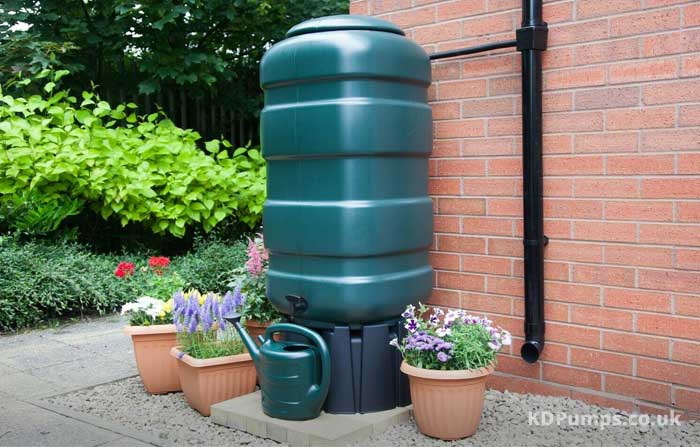
Rainwater harvesting is the term used to describe the collection of rainwater.
This can be stored as well as used for a variety of purposes, including gardening, landscaping and an alternative source of drinking water after filtration.
Systems of collecting rainwater for everyday use vary from simple water butts to more elaborate mechanisms involving tanks, plumbing and pumps.
Rainwater harvesting is a practical and environmentally friendly technique that puts rainwater to good use rather than simply allowing it to go to waste.
Why Collect Rainwater?
There are various reasons why one should collect rainwater, including;
Free Source of Water

Image source: Pexels
While we live in homes which come with the convenience of tap water supplied by the utility companies, isn’t it better to get your own freely available supply of water?
Using tap water costs money, and prices are only increasing.
Whereas if you collect rainwater, you can save on utility bills as any water collected is completely free.
Watering Plants
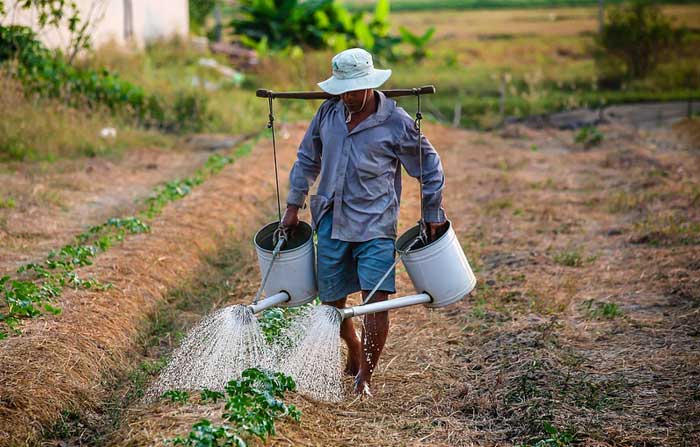
Image source: Pixabay
If you have a garden or plants you will need to water them often.
Consequently you will use quite a lot of water to be able to do so effectively.
However if you collect rainwater, you can use it to water plants.
Besides being a practical and cost effective option, there is no denying that rainwater is much better than tap water.
Plants look brighter and greener when well watered.
If the water is rainwater, it contains potassium and sulfur, as well as several minerals and microorganisms which are highly beneficial for plants.
Improves Soil Quality
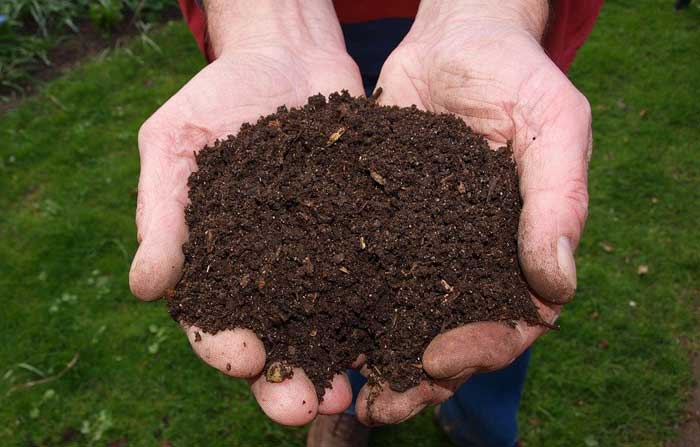
Image source: Pixabay
During the evaporation process, rainwater is distilled.
As a result, it is ideal for diluting salt backups that could be present in soil.
In case there is too much salt, generally the plants will become stunted, and at times they may even die.
Rainwater is actually a really good way to improve the soil quality.
It can also help in accentuating the fertiliser that you may have applied.
Replenishes Groundwater
Sadly construction works and the myriad of modern amenities have led to a considerable reduction in groundwater in many areas these days.
Hence, by collecting rainwater you would be helping the groundwater to replenish, thereby leading to healthier and better landscapes.
It’s Easy!
Collecting rainwater is very simple. After all, it comes straight down from the sky.
And thanks to the power of gravity, there’s really no need for complicated systems or techniques to collect it.
You can place several barrels directly below gutter downpipes and collect a lot of rainwater.
Methods to Collect Rainwater Without Gutters
All rainwater harvesting systems will need the following key elements in order to catch water:
- The catchment surface – the bigger this is the more water you will be able to collect.
- The conveyance system – in cases where there are no gutters you will need to use the drip conveyance system, that is the water will be dripping or flowing directly into a container or vessel.
- The container – this could be anything from a bucket to a barrel or a tank. In case you do not plan to use the collected water immediately or within a short period of time, make sure to use a container that can be closed with a lid or in some other way to reduce evaporation as well as avoid having any pests get in.
- A way to access the collected water – the most common option is to have a container with a spigot but there are other options you could apply.
In more practical terms, you will require some wood to build a simple platform, a garden spigot, gutters, downspouts and elbows.
It will depend on what type of rainwater collection system you intend to build, but these materials are generally a must.
In truth, you can manage to construct a rainwater collection system very simply, and it will only cost you minimal investment.
And within a short period of time, it will definitely pay off since you will be able to catch and store rainwater, thus saving on water bills over time.
There’s no doubt that the best way to collect rainwater is to have gutters that will channel the water into downpipes and then to a water vessel.
However, if you do not have gutters you can still collect rainwater.
The following are some of the most commonly used methods to collect rainwater:
Catchments
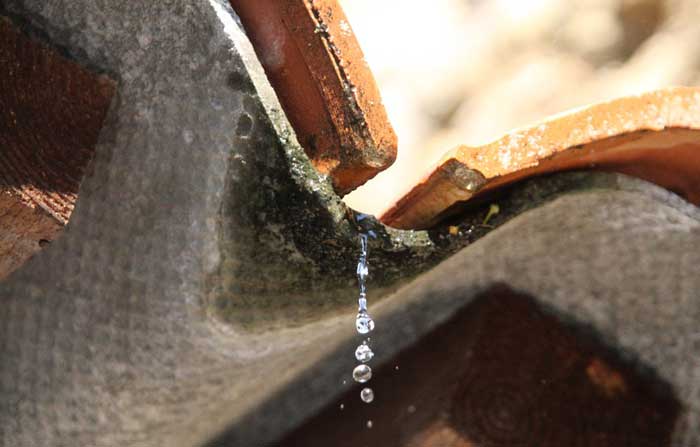
Image source: Pixabay
There are certain places on your rooftop where the rainwater gets directed naturally down a certain pathway.
This is referred to as a catchment area.
For example, in the case of a slanting rooftop, the water will get directed down naturally.
In cases where there are two sections of the roof coming together, there will be a single catchment line which will lead the water into a single stream.
Hence, even if you do not have any gutters, you can still make good use of such catchment areas as at the end of the day, they work just like gutters.
You can have a drainage pipe or a collection vessel in such catchment areas to collect rainwater.
You can also help in distributing the rainwater.
Collecting water from catchment areas is not only a practical way to get free water.
It’s also good practice to avoid having water building up in such areas as this could potentially lead to damage.
Diverters
Diverters are very similar to gutters.
They are basically metal sections which can be installed above doorways or flower beds to protect them from rain.
They are generally made from aluminum, at increments of a few feet.
They are fitted to the underside of the roof shingles, and they effectively create a wall, which will then divert the rainwater to other areas, hence their name.
Tarpaulin
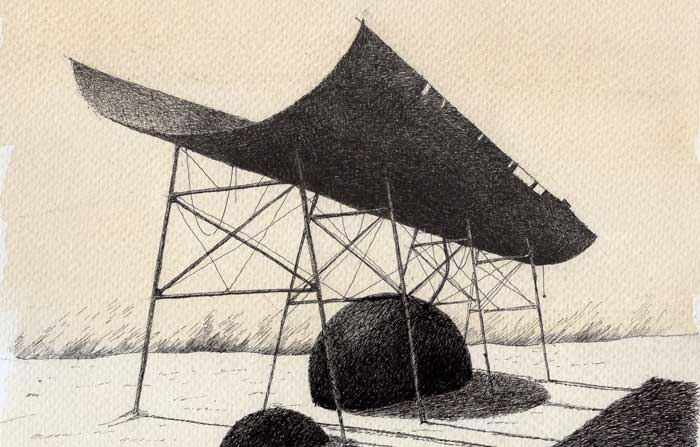
Image source: Etsy
A tarp is a great way of catching rainwater.
It is relatively easy to set up as it is lightweight, and you can find tarpaulins in various sizes.
The most important thing is that you set up the tarp in such a way that all the rainwater will drip to the same point.
You can do this either by making a hole in the middle of the tarp, or else rig the tarp so that it angles downwards.
You will be amazed to note that if it is set up correctly, a 9’ x 9’ tarp could manage to catch some 36 gallons of water.
However, the intensity of the rain and the duration will have an impact on how much water you can gather.
Butterfly Rainwater Catcher
The butterfly system is one of the rainwater catchment systems you could construct.
It has been given this name because it has two sides which are angled upwards, just like the wings of a butterfly.
When the water hits these ‘wings’, it will flow towards the central part of the structure.
From here it will then drip into a collection device.
It is quite simple to set up such a system.
The most important thing is to have the midline sealed.
It is also important to choose a vessel that is large enough to cater for rainwater collection.
If there is heavy rainfall, you may end up with unnecessary wastage if the vessel overflows.
Umbrella Rainwater Catcher
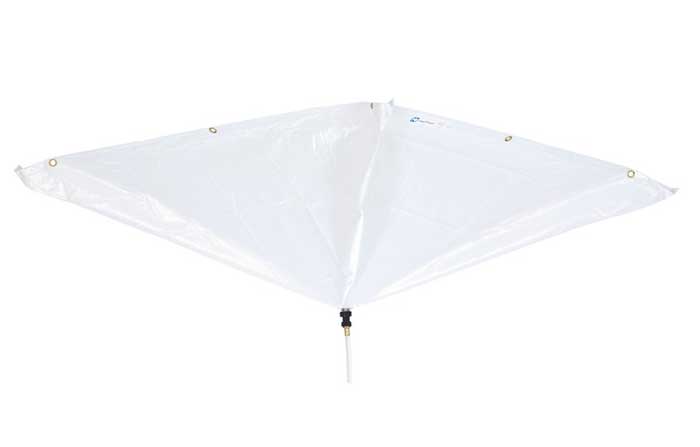
Image source: Amazon
The umbrella rainwater catcher system, or as it is sometimes called, the saucer rainwater catcher, is essentially an umbrella in an upside-down position.
The system will comprise an inverted umbrella, within which there will be a hole. This will lead directly into a conveyance tube in the middle so as to collect the rainwater.
It is important to ensure that such a system is well anchored as in case of a strong wind it could fall over.
These kinds of rainwater collection systems can be built as a DIY project.
You may even order a custom made one online.
In the latter case, there will be varying specifications, such as the materials used and the size.
Ponds
Another option is to dig a pit and line it with plastic.
This rain pond will allow the rain to accumulate within it and so you will be able to collect rainwater.
The main disadvantage of this method is that a considerable amount of water will end up evaporating.
If the water is left unused, it could end up getting dirty and stagnant.
It is also worth mentioning that in some places it is not permitted to build a pond on one’s property unless a permit is acquired.
Containers & Barrels
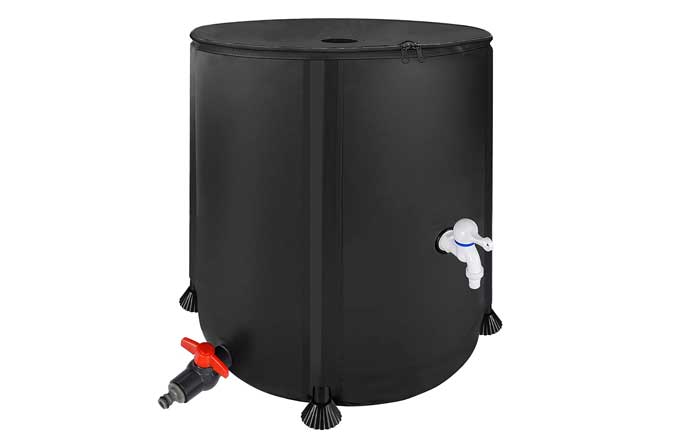
Image source: Amazon
Using containers and barrels is the simplest and most traditional method of collecting rainwater.
Collection vessels are not costly, and there is no need for installation or complicated methods.
Barrels can be stationed anywhere, or else you could opt for barrels that connect to underground pipes to channel the rainwater to certain areas and create an irrigation system.
If you are going to opt for barrels, it’s a good idea to bear in mind the following things:
- Try to place barrels in areas where there is shade as too much exposure to the sun will lead to algae growing.
- You may wish to apply a capful of chlorine bleach every once in a while so as to reduce algae from forming.
- Once a month it is best to empty the barrel to clean it. You will need to scrub it out with some baking soda and water to eliminate any odours.
- It is a good idea to use barrels with a diverter. The diverter will shut off when the barrel is full, and the rainwater will flow out. This is important in case the area around the barrel should not be allowed to flood as otherwise you may simply allow the barrel to overflow in case of very heavy rainfall.
Drainage Swale
The word ‘swale’ refers to the method of contouring the ground by means of a shallow ditch.
In such a way rainwater is directed to a particular location.
It also helps to slow down the rainwater runoff, or direct it away from the foundation of the property.
It can then be used for landscaping purposes.
Swales are often used to prevent rainwater from draining into the sewers where the storm water ends up.
The rainwater can also soak into the ground more effectively.
At times swales are gentle and almost invisible.
Often these are disguised with grass over the surface.
Other times swales are ornamental landscape features.
The option of how to build the swale depends on the particular location, the slope and the amounts of rain that typically fall.
As a general rule of thumb, if the swale is intended to direct runoff water to a rain garden, this should be located at a low spot to serve as the final point of the swale.
Swales can be excavated by a shovel.
But in case of a large rain garden you may need to consider hiring a contractor to move the earth by means of power equipment.
You will also need to take into consideration the patterns of the water flow.
If the rainwater runoff is usually quite light, then a simple shallow swale that is about 2 feet wide should suffice.
However in case of heavier runoffs, a wider and deeper ditch will be needed to hold more water.
Conclusion
Collecting rainwater and putting it to good use is not only sensible but also an environmentally friendly measure.
There are various options which you could adopt, and there is no need to spend much or engage in any difficult tasks to adopt a rainwater harvesting system, as we could see above.
Besides, you will be able to save money too, so it is definitely worthwhile!


Comments are closed.